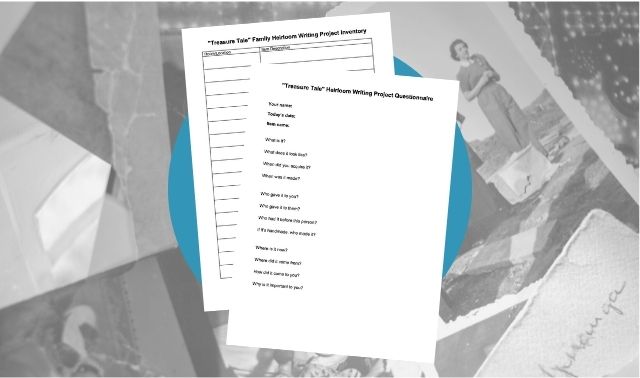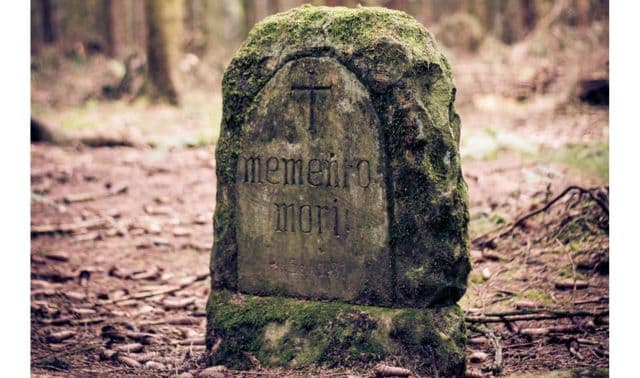
Have you unearthed any buried treasures lately? Not gold doubloons, but the kind of family treasures whose value is measured in people, places and memories rather than in dollars and cents.
We all groan when the experts on “Antiques Roadshow” say, “Of course, this item would be worth considerably more with a letter or some record of how it came to be in your dad’s hands.” Whether it’s the cast-iron griddle that cooked Abraham Lincoln’s flapjacks at your great-grand-aunt’s tavern or an original sketch by cartoonist Charles Schulz, an artifact’s written history (what historians call a provenance) can be the difference between obscurity and fame.
One day, you or your heirs might need to downsize a lifetime of objects. Imagine your son trying to decide what to do with all the books and mementos on your office shelves. He knows you want the genealogy books donated to the local society, but then he’s confronted with the other bits and pieces on display, unsure why they were important to you. He picks up a hand-carved wooden racer, the paint mostly gone, the wheels wobbling on the axle. Was this the one he built with you for the Cub Scout Pinewood Derby? Who knows? The little racer falls into a box headed for the trash.
The treasures in your closet may not have a presidential connection, but they’re precious to anyone in your family who knows their stories. Unlike letters or documents with names, dates and places, family artifacts are often left unlabeled and their histories get lost. Without a past, that treasure and its untold history may be tossed out. Time you spend today to identify and record the history of your treasures will give them a better chance to survive into tomorrow.
Fortunately, writing a provenance—what I call a Treasure Tale—is easy. All you need is a bit of time, your knowledge of the heirloom and your favorite writing tools. You’re the expert, and our guide will show you how to craft a Treasure Tale for each of your family heirlooms.
Step 1: Make an inventory.
The first step is to inventory your family heirlooms. If you don’t have many, start with those that come to mind first; they’re probably the most precious to you. List each item on the Treasure Inventory you can download above. At this point, all you’re doing is making an inventory, so the only information you need to record is Room, Item and Location.
If you have many treasures, you may want to tackle the project one room at a time. If you’re working room by room, walk into the space, pick a starting point and work your way around the room clockwise, listing items as you see them. Remember to look in closets, drawers and cabinets. Complete the inventory of at least one full room before you do anything else.
Step 2: Interview your heirlooms.
When you’ve completed the inventory, you’re ready to record what you know about each treasure. You will need the five questions below and one sheet of paper for each item, or a copy of the Treasure Tale Questionnaire you can download above.
Use brief phrases in answering the questions. Don’t get bogged down trying to craft carefully worded, complete sentences. We’ll come back to pulling everything together in a narrative after you get the basic facts down.
Write what you know, and resist the temptation to stop and call someone for more information or to wait until you can find out the rest of the story. Enter a question mark if you don’t know an answer; enter N/A if a question doesn’t apply.
What is it? What does it look like?
Jot down a full description of the item. Write a word picture that will allow a reader to visualize it. Use a ruler to measure it. Describe the color and kind of material. Look for clues that might date the item or give an idea of style or design. An old-fashioned magnifying glass or jeweler’s loupe may help you find a silversmith’s hallmark or handcarved initials. Take time to examine your item closely for any surprises.It’s the rare family heirloom that lasts for decades without a few scratches. Sometimes each generation adds its mark, quite literally, and that mark can be the kernel of the treasure’s story. Silver baby cups with teeth marks or a wooden box the dog tried to fetch — make note of every scar and blemish.
When did you acquire it? When was it made?
Write down this information, if you know. If you can’t remember exactly when an object came into your possession, try thinking in terms of an event it’s connected to, such as when you first remember placing that ornament on your family’s Christmas tree.What if you have only a rough idea of dates? Enter your best guess with the qualifiers about (abt), probably (prob) or unknown (unk). These terms alert others that you are entering questionable information, but it’s better than not writing anything.
Who were the previous owners? If the item is handmade, who made it?
Your heirloom probably belonged to someone in an earlier generation—probably many someones—before it came to you. Do your best to record the chain of ownership of your treasure. The age of the item should give you some idea of how many generations it may have gone through. Note the person who gave it to you and note anyone else who possessed it—each with full name, birth and death dates. If it’s handmade, write down who made it, too. If you determine previous ownership through an indirect means (such as a diary or news clipping), make note of this.
Where is it now? Where did you find it? Where did it come from?
Start with the present and list every place the heirloom has been, including address, city and state. Family historians just love addresses and hometowns. They help us place people in their homes and communities. Your family heirloom, just like your ancestor, may have traveled many miles before settling down. Include at least the town where the previous owners lived when they held the item. Your list of owners may help answer this question.
How did it come to you? Why is it important to you?
It may seem as though you’ve always owned the treasure, but it didn’t come out of thin air. Try to recall how or why you came to be its caretaker. You have already written down who owned the item previously and where it came from; now record how it came to you. Was it a gift for a special occasion? An inheritance? Perhaps you discovered it with an ancestor’s belongings.
Sometimes the how and why of a story are the most important, revealing tidbits of buried treasure. Make sure you write down any associated memories, traditions or stories.
Step 3: Refine your notes.
You should now have a Treasure Inventory listing the family heirlooms you hope to preserve, and a completed Treasure Questionnaire for each item. Sign and date each sheet.
After you’re done, go back and reread your notes. Think about what questions your heirs would have. Can you fill in any blanks? Now is the time to make a few phone calls to relatives who might be able to offer forgotten names, dates or places. Act like a reporter and aim to get the facts. Don’t leave anything blank.
If you’d like to tidy your writing, use the questionnaires as a starting point to craft a brief statement of provenance for each treasure. Write full sentences from your answers to create a Treasure Tale. This approach allows you to share any stories you might remember and add comments for further investigation. You may never know the full name of a previous owner, but your clues may help future family historians solve the mystery. (See the box at right for an example of a finished Treasure Tale.)
Collect all the inventory sheets and questionnaires and place them with your will and trust papers in a clearly marked envelope. Be sure to let your tell your family it’s there, and for added insurance, make copies to keep in different locations or give to each of your designated heirs.
Step 4: Share your treasures.
You’ve done the hard work—now it’s time for the fun stuff: sharing your treasures with your family.
The simplest way is to organize the information in a binder. Include all the inventory sheets as well as your Treasure Tales. You can even have the pages bound at a copy center with a cover sheet identifying your family, and add a family tree chart if you like.
If you feel energized after cataloging your collection, further document your heirlooms by taking a photograph of each item. Print the photos (or order traditional prints) and include them with the Treasure Tales. This visual catalog will help you and your heirs easily identify those valued treasures. You can also give each of your family members a copy as a gift.
If you prefer using a traditional photo album, buy one with room for notes. Place each photograph in the album in the order listed on your Treasure Inventory, and add the corresponding descriptions. You could even create a professionally printed photo book using a service such as Shutterfly or Snapfish.
It’s also a good idea to write a condensed version of your Treasure Tale to keep with the item. Print the short description, trim it down to size and slip it inside a vase or mug, tuck it into a jewelry box, or drop it into a clear polyester sleeve with a letter.
Whether you use quick notes to record the bare minimum of information or you assemble a full photo album’s worth of Treasure Tales, the time you spend today recording the history of your family’s heirlooms is vitally important. Your hard work gives your mementos a better chance of surviving and shows future generations just how precious your family’s treasures are.
Tip: Ask family members about an heirloom’s provenance—the history of an artifact, especially the record of its chain of ownership.
Treasure Tale Example
Here’s how a completed provenance questionnaire turns into a Treasure Tale.
Questionnaire answers
- What: Oval photo brooch, 1.5 inches high x 1.5 inches wide with rope frame. Back held in place with small brackets. Brooch encloses a photograph of Lucile Paulen, about age 3-5. No glass. Possibly brass. Photograph is stained and faded.
- When: Brooch found in box of letters and photographs given to me in 1996 by Aunt Sally.
- Who: Previously held by Aunt Sally Jane Smith (1926-1996), who inherited it from her mother, Arline Kinsel Brown (1890-1963). Lucile Mae Paulen was born 1908, photo probably taken 1911-1913.
- Where: Now kept in my jewelry box at our house, 123 State Street, San Francisco. Sally Smith and Arline Brown’s last address was in Santa Ana, Calif.
- Why, how: When Aunt Sally sold her house at 456 Olive Drive, Santa Ana, Calif., she moved Grandmother’s things from the steamer trunk where they had been stored into cardboard boxes. She kept the trunk and gave me the boxes filled with papers, photos and miscellaneous items.
A version of this article appeared in the January 2011 issue of Family Tree Magazine.






